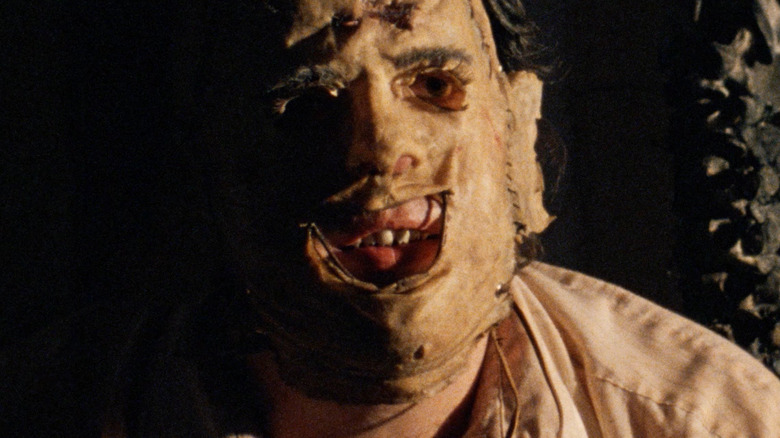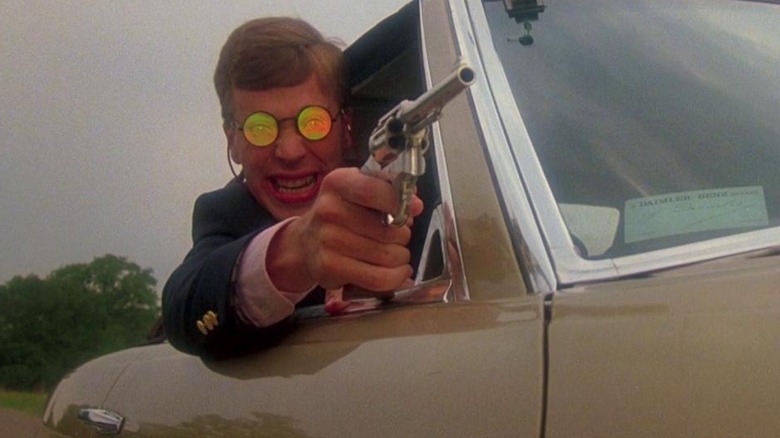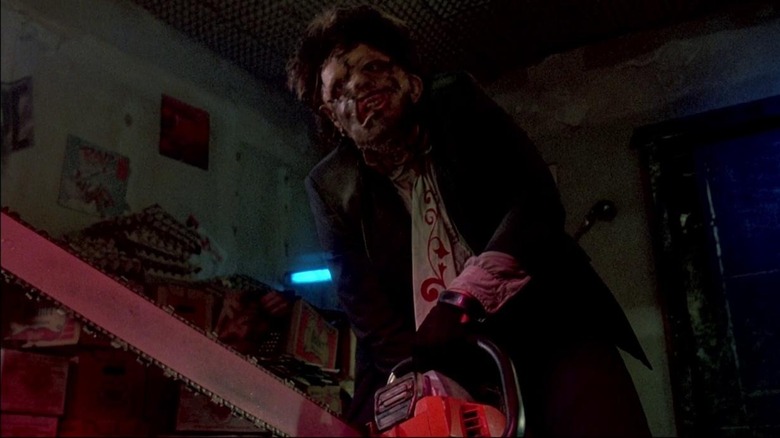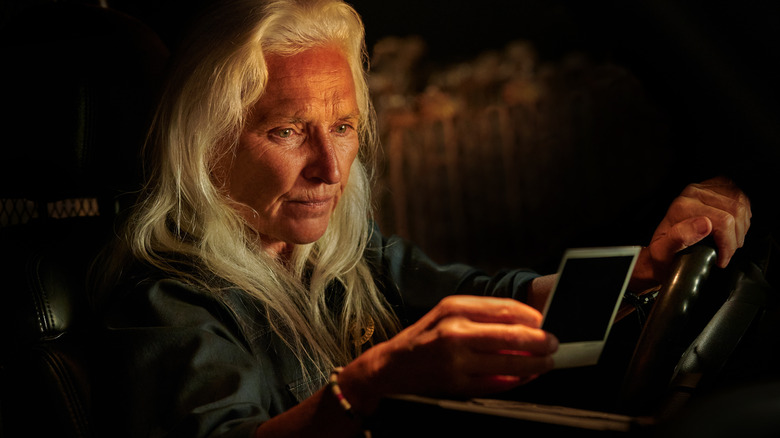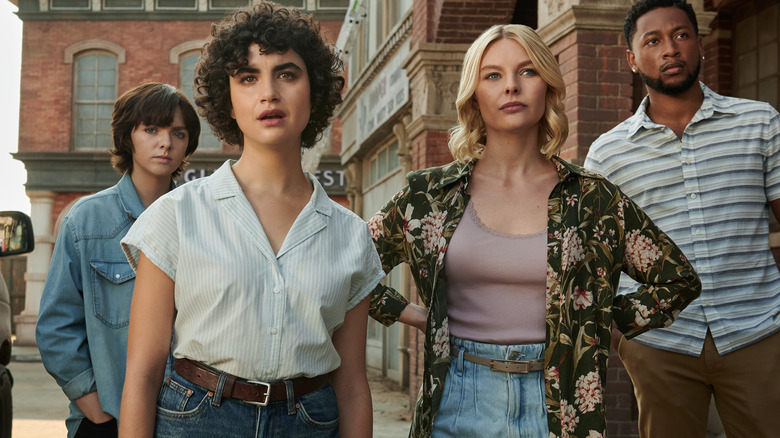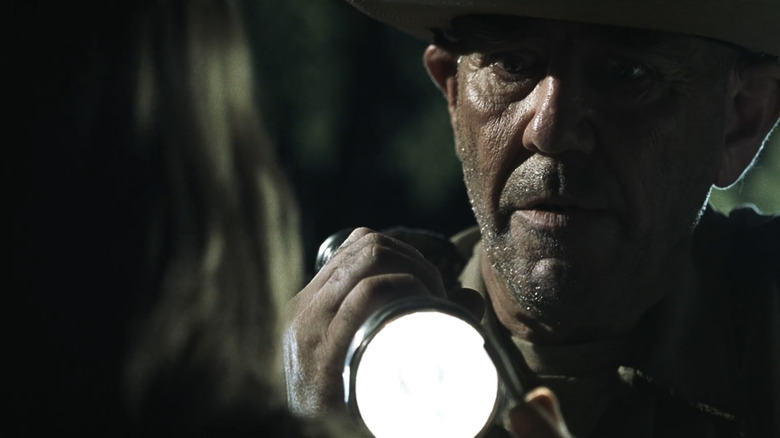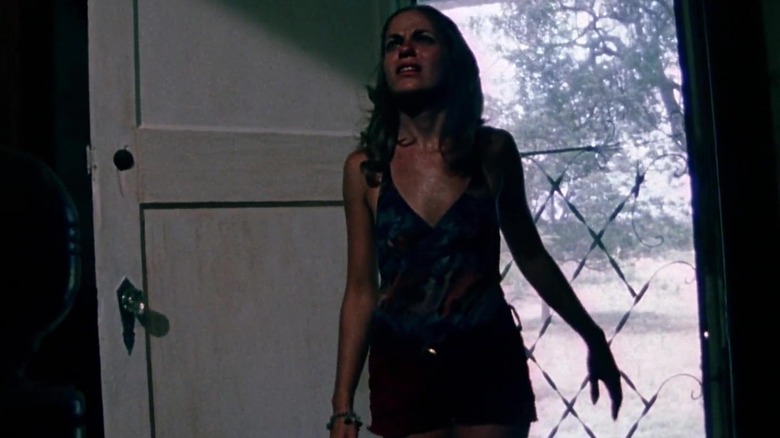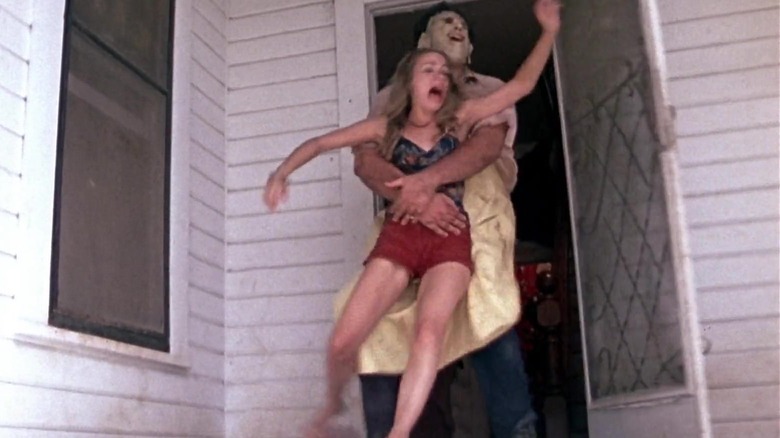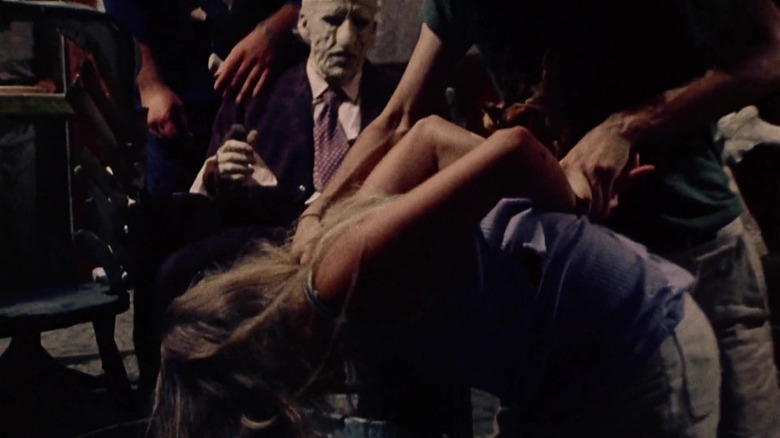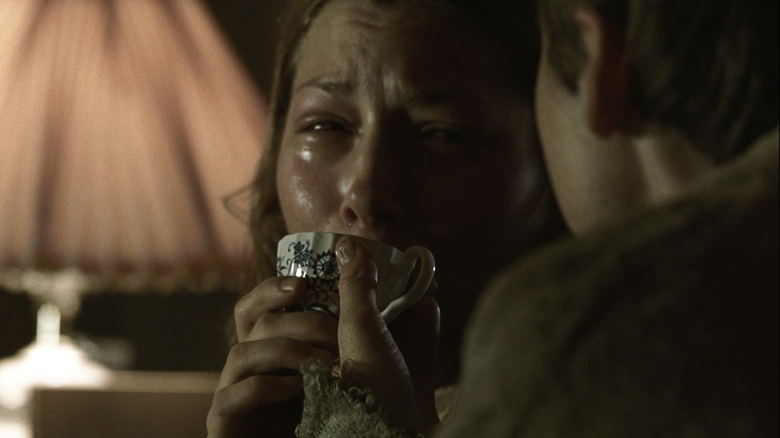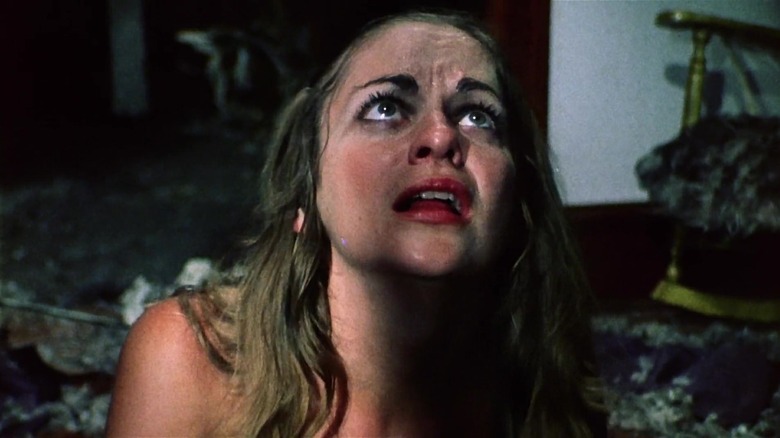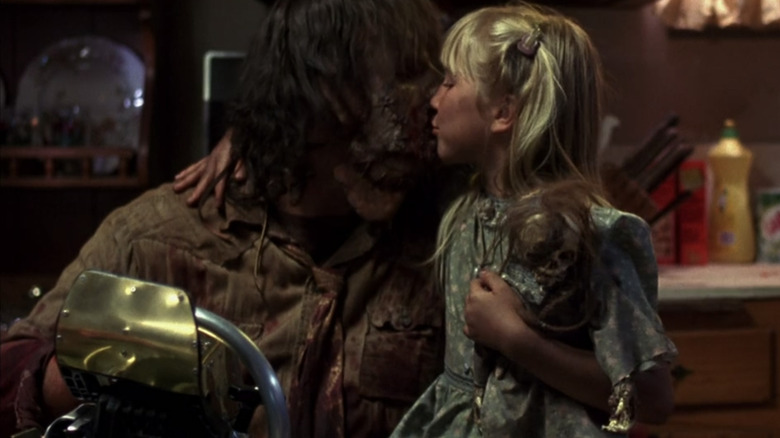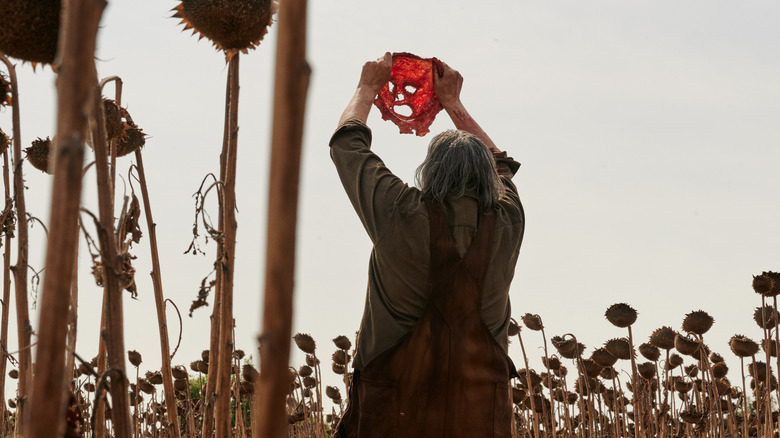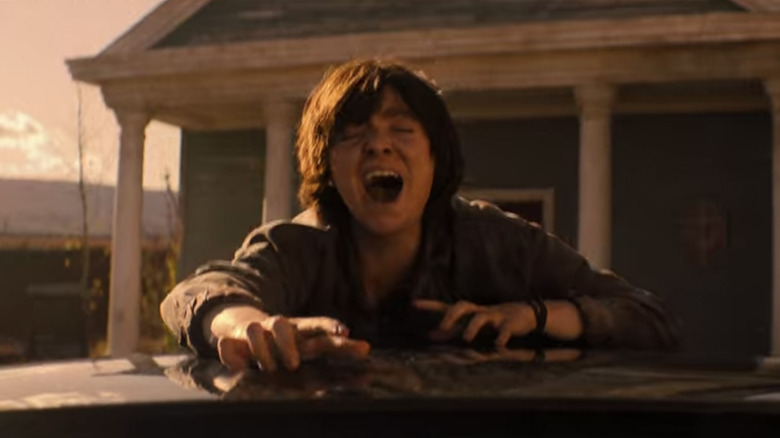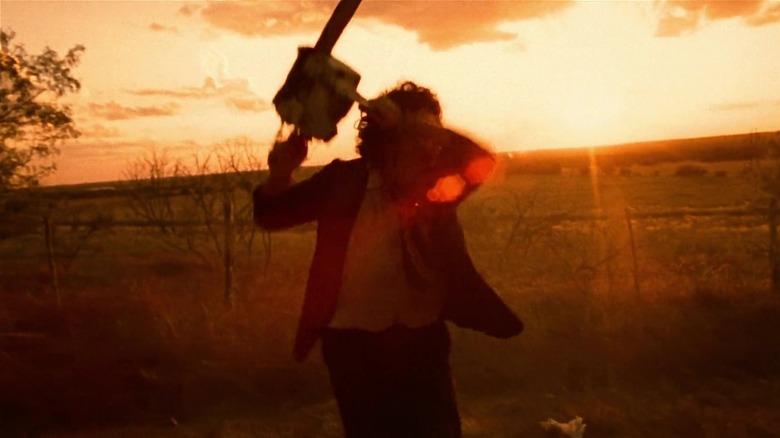Things That Happen In Every Texas Chainsaw Massacre Movie
Tobe Hooper's original low-budget horror masterpiece, "The Texas Chain Saw Massacre," premiered in 1974, and the horror genre hasn't been the same since. The years spanning 1974 to 2022 gave us nine "Texas Chainsaw Massacre" movies, and while none of the sequels can quite live up to the original, this is a franchise that's stayed surprisingly close to its roots. You won't find Leatherface venturing out into space, clashing with any other horror icons, or returning as the undead. He's strictly a Texas-based killer, and generally, his motives are as simple as they've always been.
That doesn't mean that all the installments are interchangeable. Not all of the movies even make it clear that Leatherface and his family are cannibals, and their names and numbers are equally fuzzy and variable. Most of the films pick and choose what timeline they want to follow. This isn't a franchise heavy on series mythology — it's more like each film explores a different angle on the same basic idea.
That basic idea is a rich one, and it has some surprising constants. Despite their technical, tonal, and stylistic differences, all these movies have some fascinating points in common. Let's grab a knife and fork, and dig into what Leatherface is serving up. (This is the one time that's a good idea.)
There's always a culture clash
Leatherface and his family haven't shrugged off the cultural taboo against cannibalism as much as they've moved the goalposts for it. Other people are meat — but they have to be other people. With rare exceptions, they're not killing other country folk. There's always a distinct culture clash between the killers and their victims.
The films often emphasize this by having the hapless protagonists come from far away, only crossing into Leatherface's territory for a visit (to check their grandfather's vandalized grave or claim an inheritance, for example), or on the way to somewhere else (like a Lynyrd Skynyrd concert). No matter where they're from or why they've turned up, though, they're part of a different world. They're hippies, yuppies, suburbanites, high school kids, representatives of law and order, or gentrifying hipsters. The culture clash can even precipitate the violence, creating situations where Leatherface and his family have to either surrender to civilization and the changing world — or else fight back.
They tend to fight back ... and they usually win.
Leatherface shows a real attachment to his saw
"The Texas Chainsaw Massacre" movies make one thing clear: Leatherface sees his chainsaw as more than just a means to an end. Every series installment marks it as special to him.
Usually, his kills are brutally practical. He's eliminating problems and putting food on the table, and that's it — but when he gets his chainsaw revving, he can't help wanting to show it off. It's the one time he seems to consciously understand how terrifying he is, and instead of just wielding the chainsaw, he brandishes it. It's an extra touch just to frighten his victims, and express whatever he's feeling at the time.
A lot of the movies even go out of their way to show Leatherface getting the saw. In "Leatherface," it's a birthday present from his mother; in "The Beginning," it's a trophy he takes after killing his old boss at the slaughterhouse. In "Texas Chainsaw Massacre III," his family surprises him with an upgrade: a gold chainsaw engraved with "THE SAW IS FAMILY." Leatherface and his chainsaw just belong together, and you don't want to get in the way of true love.
Artifacts of past victims are on display
It's an agonizing touch that in "Texas Chainsaw Massacre" movies, the terrorized characters are always surrounded by signs of the family's past victims. It can be gutting for them to realize how often these people have gotten away with it — and that's even aside from how viscerally horrible it is to fall into a pit of bones or see a wall adorned with keys taken off countless victims.
Even when these sights aren't horrifying for the characters themselves, they can certainly give us chills. There aren't too many past victims in the prequel film "The Texas Chainsaw Massacre: The Beginning," but we know that Sheriff Hoyt spends most of the movie dressed in a murdered man's uniform. These are definitely killers who like to take trophies.
The most painful reminder, however, comes in 2022's "Texas Chainsaw Massacre," when Sally Hardesty returns to the franchise — and reveals that she's so devoted to killing Leatherface that she's become someone who's willing to use other people as bait to get what she wants. She's an upsetting cautionary tale for "final girl" Lila: This is who she might become someday.
There are signs of trouble before things really kick off
No one in "The Texas Chainsaw Massacre" is ever completely prepared for the hellish situations they stumble into, but at least the cannibals they meet aren't ruining an otherwise perfect day. The final girl and her friends are already having problems before Leatherface shows up revving his chainsaw.
In some cases, the dark clouds hanging over them are still Leatherface-related — the tombstone vandalism and graverobbing that bring Sally and Franklin to their old family home, for example, and then Sally and Franklin's deaths get their Uncle Lefty involved — but that's not a universal rule. Michelle and Ryan are stuck on a tense pre-breakup car ride, Dean's trying to hide the fact that he plans to burn his draft card, Lila's still traumatized from surviving a school shooting ... one way or the other, there's always trouble in pre-cannibal paradise.
The different movies use this setup in different ways: to establish an ominous tone, to push the plot along, or to provide extra characterization. Unsurprisingly, though, whatever is going on tends to fade into the background once chainsaws get involved.
Leatherface isn't the worst villain
We wouldn't want to cross Leatherface's path ... but the fact is, every movie goes out of its way to suggest that he's actually the lesser of two (or more) evils.
For one thing, generally, the movies imply that Leatherface isn't intellectually capable of realizing the full weight of what he's doing. On top of that, as Game Rant explains, he's had his whole worldview shaped — and warped — by his abusive, domineering family, most of whom are far more deliberate and vicious than he ever is. When you look at all the psychological torture they inflict on their captives, it's easy to see that Leatherface is the best of the bunch. In "The Texas Chainsaw Massacre 2," Stretch even convinces him to spare her. You're not going to get that deal from any of his brothers.
When his family's not around to make him look better by comparison, other forces pick up the slack. In "Leatherface," his burgeoning transformation into a killer is the direct result of a campaign of vengeance and police brutality; in "Texas Chainsaw 3D," the real third-act villain is a power-hungry posse leader. Even in 2022's "Texas Chainsaw Massacre," when his incredibly brutal murders are a solo act, he only returns to killing when a gentrification effort inadvertently leads to his surrogate mother's death. Before that, he spent years minding his own business.
People can't help trespassing
If you suddenly find yourself in a "Texas Chainsaw Massacre" movie, there's one guiding rule you should follow: No trespassing.
These movies are full of people going where they haven't been invited. Obviously, we'll give them a pass when they're only sneaking onto someone else's property in order to try to rescue their friends, but trust us, that's not always the case. In fact, the whole series is kicked off by a case of trespassing: In the first movie, you can tell that Leatherface is confused and alarmed by the fact that these kids keep wandering into his house. Just because you're looking for gas doesn't give you the right to stroll right into someone else's home, Kirk!
Basically, unless you're attempting a heroic rescue or running for your life, it's best to steer clear of anyone else's house or land. This is a family that takes property lines very, very seriously.
Someone gets manhandled
Not all slasher movie villains are burly enough to manhandle their victims, and even the ones who are capable of hauling someone around don't always want or need to. Leatherface, however, can and does manhandle — and he does it with a sickening purpose. Quite frankly, in this franchise, the characters who just get quickly dispatched with the chainsaw are the lucky ones. When Leatherface drags you deeper into the house, you're in for a much worse time.
This is where the series' focus on butchery and murder as family activities really comes in. If Leatherface grabs a victim while they're still thrashing around, it's usually because he's either bringing them back to his family — maybe to be a guest at the world's worst dinner party — or because he wants to get some of the meat preparation process started while they're still alive. In some cases, he even prefers to strip off someone's face while they're still alive, as poor L.G. found out in "The Texas Chainsaw Massacre 2."
Essentially, when you see someone getting manhandled in a "Texas Chainsaw Massacre" movie, that means Leatherface has already started to see them as either a gift or as raw material ... and that almost never ends well.
Other weapons get a chance to shine
Even though the chainsaw gets top billing, no "Texas Chainsaw Massacre" movie ever relies on a single weapon. It's not a franchise that specializes in inventive deaths, but that doesn't mean it lacks variety.
In the first movie, one of the grisliest details is how mundane and industrial Leatherface's tools are: He's working with a chainsaw, meat hooks, a hammer, and a freezer. He's using slaughterhouse equipment, and he's treating people like meat because that's all they are to him. The other members of his family enjoy torturing their victims and drawing out their suffering — and the later movies provide their sadism with plenty of sickeningly creative weapons — but Leatherface's workmanlike approach has its own horror.
We don't want to overlook the more spectacularly bizarre implements Leatherface, his family, and his victims have picked up over the years, though. The gold medal for weirdest weapon used to go to "The Next Generation," where Matthew McConaughey's character uses his cybernetic leg to step on a girl's head and slowly crush it. But 2022 brought us Netflix's "Texas Chainsaw Massacre," and the disturbing sight of Leatherface breaking a man's arm and then stabbing him in the throat with his own broken bone. Suddenly, the chainsaw seems pretty tame.
The first rescue never works out
One of the most brutal gut-punches in "The Texas Chain Saw Massacre" comes when an already shattered Sally, who has just seen her brother murdered in front of her and barely escaped with her life, seeks shelter with the friendly gas station owner — only to find out he's just another part of Leatherface's family tree.
It's such a memorably terrifying, dread-filled moment that all the other films in the series imitate it to some degree. Characters in "Texas Chainsaw Massacre" movies always have a moment of seeming escape, refuge, or safety that turns out to either be false or extremely short-lived. One minute, you're getting soothing comfort, and the next, you're served drugged tea, struck with a cattle prod, or shoved into the trunk of someone's car.
Occasionally, the rescue falls apart without the help of Leatherface's extended family. In the most heroic scenarios, characters will sometimes reach genuine safety, but reject it to go back to help someone else. Recent films have sometimes gone with another twist: In "Texas Chainsaw 3D" and 2022's "Texas Chainsaw Massacre," the main characters are betrayed by someone hoping to catch Leatherface. No one wants to reach safety only to find out they're going to become bait.
You get a tour of Leatherface's home, whether you want one or not
For the most part, Leatherface's family home won't be turning up in Architectural Digest or Better Homes and Gardens, but that doesn't mean he's not happy to show it off to his most unwilling guests. "Texas Chainsaw Massacre" characters are always stuck getting a tour, whether they're being dragged from room to room, or creeping through silently in the hope of avoiding detection. The house tour is a franchise staple partly because it amps up the horror by showing you endless grime, inventively grotesque bone sofas, and preserved and leathery corpses.
Even more than that, though, the exploration of the home emphasizes the series' focus on family. Ginny's orphanage-turned-home in 2022's "Texas Chainsaw Massacre" isn't innately horrifying — aside from the chainsaw entombed in her wall — but the characters' exploration of it highlights the mother-son connection between her and Leatherface. All of a sudden, we can see the weirdly ordinary domestic life that the protagonists' arrival has ruined. The luxurious Carson estate in "Texas Chainsaw 3D" is immense and beautifully furnished, and inheriting it prods Heather into grappling with — and eventually embracing — her troubling and bloody heritage.
Displays of warped family love
The cannibal clan at the heart of "The Texas Chainsaw Massacre" series may not have a consistent family tree or even a consistent name, but what they do have is a lot of love ... and that warped, unhealthy, obsessive, and toxic love is on display in every movie.
In the harrowing dinner scene in the original movie, it's clear the whole family is really pulling for Grandpa to get to show off his legendary hammering skills. The darkly comedic tonal clash of their sadistic glee towards Sally and their manic cheerfulness towards the big family event is part of what makes that moment so hard to take. There's a lot of violence within the "Texas Chainsaw Massacre" family — in "The Beginning," Sheriff Hoyt even forces an unnecessary double-amputation on Uncle Monty — but no matter what they do to each other, they're still a tight-knit group. They'll usually go to any lengths to protect or avenge what few people they care about.
If you want proof of the overwhelming pull of family loyalty in these movies, look no further than "Texas Chainsaw 3D," where Heather bands together with her long-lost cousin Leatherface just a few hours after he killed all her friends.
Leatherface updates his look
We'll say this for Leatherface: He has a clear sense of personal style, and he's not afraid to let his look evolve.
When it comes to clothes, he has an extensive wardrobe that includes everything from butcher's aprons to suits to dresses. When you compare him to other slasher icons who are happy to spend decades in their hockey masks or red-and-green sweaters, he stands out. He'll even put on a little makeup from time to time. (He's not necessarily that great at applying it, but in his defense, it's probably hard to put lipstick on the shriveled lips of your people-skin mask.)
The most significant way he changes his look, however, is by changing his mask and wig, which he sometimes even does multiple times in one movie. Greek tragedy inspired Tobe Hooper's take on Leatherface's masks, so filmmakers can use his changing face to reflect not only his mood, but also his role within his family, and within the story. The gruesome process of removing someone's face is always good for a jolt of fear and disgust, too, so this is a character beat that doubles as a recurring scare.
The ending emphasizes the trauma
The poster for the original "Texas Chain Saw Massacre" asks one of the horror genre's most devastating questions: "Who will survive and what will be left of them?" (via IMDb)
In this franchise, the answer is always the same. If any of these characters make it out of this meat grinder alive, they're never going to be the same. In the campier and more comedic movies, surviving characters may just emerge rattled, exhausted, and battle-hardened, but these best-case scenarios are few and far between. The first film ends with Sally Hardesty escaping in the bed of a pick-up truck, screaming, sobbing, and covered in blood. That's the classically grueling ending of the series, and an Easter egg in Netflix's "Texas Chainsaw Massacre" pays homage to it by ending with a helpless and horrified Lila stuck in a self-driving car, unable to save her sister.
You'd think that the installments that end without any surviving victims at all would be the exception to the trauma rule, but no one gets out of these movies intact. While the Hewitt family comes out on top of all the slaughter in "The Texas Chainsaw Massacre: The Beginning," they also come out missing teeth, legs, and any lingering inhibitions about cannibalism. In another sequel, "Leatherface," Jed ends up so hollowed out by grief, rage, and pain — and so ashamed of his newly disfigured face — that the last scene shows him creating his first mask out of human skin. Trust us, there's always enough trauma to go around.
Honorable mention: Leatherface lives
While the "Friday the 13th" movies always end with Jason dead or otherwise out of commission, and "The Nightmare on Elm Street" movies always have Freddy lose, "The Texas Chainsaw Massacre" saga consistently lets its horrifying masked killer survive, and sometimes even come out on top. The only real exception is the second movie, where it's implied that Leatherface dies when Drayton's grenade explodes. Even then, it's an off-screen death that we can easily believe he escaped from.
Leatherface's persistent survival could stem from the fact that the "Texas Chainsaw Massacre" movies have strong roots in folk horror. As Film School Rejects put it, "Landscape is integral to folk horror films, as these communities often inhabit spaces that are naturally isolating or easy to hide behind. Their enigmatic existences allow for an escape from society's stronghold and the morals, values, and lifestyles that are gripped within its fist." Leatherface isn't just a killer, he's an expression of his isolated, rural, Southern gothic environment, while the other characters usually enter as intruders. He's rooted to his location, like a permanent fixture of the landscape.
For the most part, then, you can't kill him. The best you can do is run away, knowing that he's still where he's always been, twirling his chainsaw against the rising sun in a weird, inexplicable dance.
